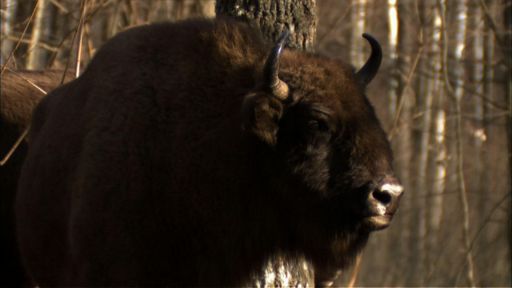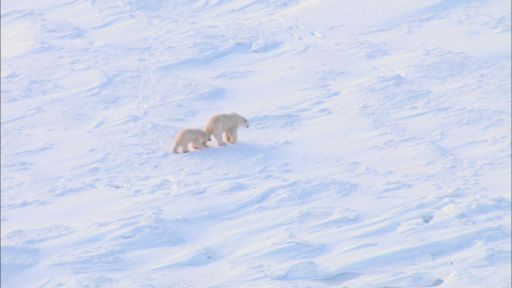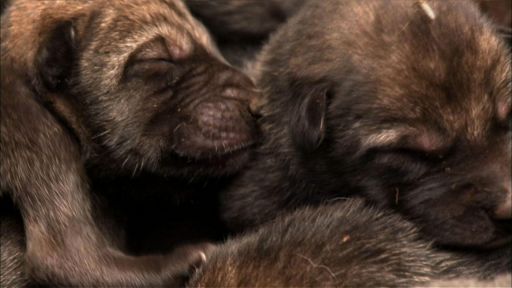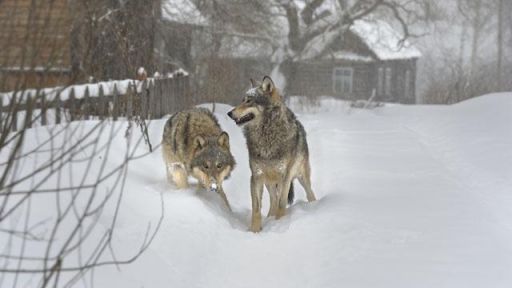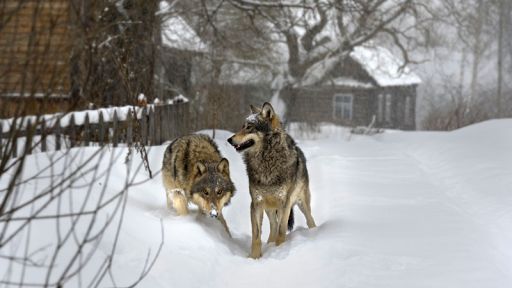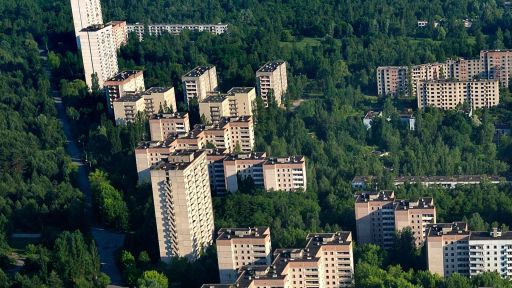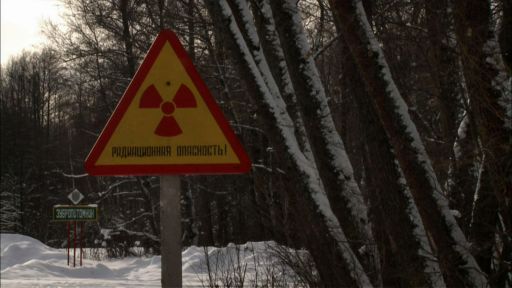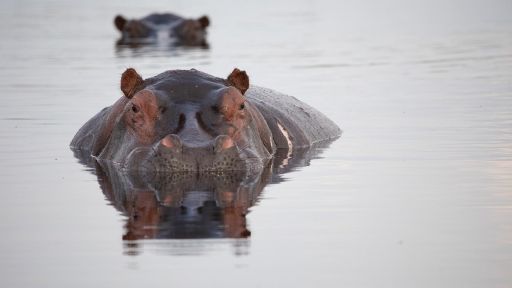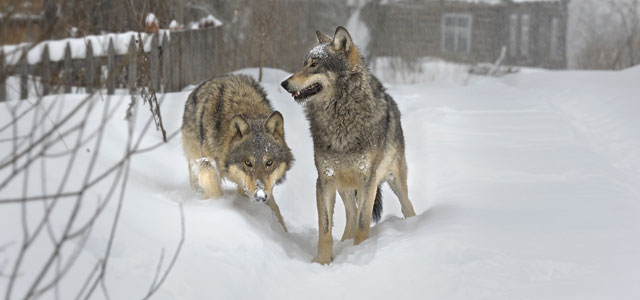
When did you first learn of the thriving wildlife populations in the zone? What about this story drew you to make this film?
I remembered Chernobyl from the day of the accident – it was quite a traumatic experience for us here in Austria. I had two young children at the time, and they were not allowed to play outside, walk in the grass or play in the sand for several weeks. We stopped gathering mushrooms in the forest, destroyed the vegetables in our garden.
Colleagues of mine (among them Nikolaus Geyrhalter) later actually visited Pripyat and shot footage there (not about wildlife), so Chernobyl was always simmered in the back of our minds.
I first learned about the wildlife in Chernobyl when researching for a BBC/ORF/ZDF series about wild Europe, “Europe – A Natural History,” back in 2003. Little was known about the status of the zone’s ecosystem in 2003, there were mostly wild rumours. The story was not included in “Europe” because of schedule and budget limitations, although I would have gone there even then. It would have been possible, at the time, to visit the Ukrainian part of the zone, where several film crews had worked over the years, but I am not sure about the Belarusian part – we did not try, nor did anyone else, as far as I know. The human history of Chernobyl was a different story altogether, and, apart from the evacuation itself, took place and is still taking place outside the zone. It was the secrecy, the lack of knowledge and images of the forbidden zone which made it seem an important subject.
What really interested me was the ecosystem bouncing back. There had been very little scientific research on wildlife in the zone until about 6 years ago when the Belarusians started some serious systematic long-term studies. Although Soviet botanists, zoologists and radiologists put in a great investigative effort in the first years after the accident, mostly in the territory of today’s Ukraine, next to nothing has been published. When the Soviet Union crumbled, all the research installations crumbled with it. In that period of political instability, much work was simply lost or possibly transferred to archives in Moscow.
How did you prep for filming in Chernobyl? What precautions did you take, considering the environment?
All visitors to the zone are accompanied and instructed by local authorities, but our team was especially lucky because our German location manager’s father is an expert on nuclear energy with access to useful knowledge and measuring instruments we were allowed to use. The list of all the precautions taken is too long for this interview, but here are the most important points: Avoid incorporating (inhaling, eating, drinking getting in touch with broken skin) anything that might contain radionuclides (smoke from timber, water, sand, animal hair, fruit, particles of plants etc.) inside the zone. That means wearing rubber boots at all times, not sitting on the ground, not brushing against plants, often wearing rubber gloves or a breath mask, sometimes even a protective suit. We wore dosimeters on our bodies at all times to control the overall exposure over time, and we carried various measuring instruments and a radiological map in order to avoid dirty areas. Washing hands and brushing fingernails frequently was a simple but important way of avoiding incorporation.
What were some of the biggest hurdles you had to overcome in making this film? How did you deal with these unique challenges?
Limited shooting time was the toughest problem. You may not spend the night in the zone and therefore have to travel from your base outside to shooting locations inside the zone over rough terrain every day. In winter and during floods, transportation was a challenge. Forest fires in summer mean that the zone is off limits altogether. The authorities there were extremely helpful in that and other respects — without their help we would have been stranded many times.
Chernobyl is a strange mix of death and life. Although you were documenting the new life springing up in the zone, often that wildlife occupies man-made ruins abandoned shortly after the 1986 nuclear disaster. What was your reaction to this stark contrast? Were there any specific images exhibiting this juxtaposition that you found particularly moving?
While the tragedy of the people who lost their homes is always felt, the houses as such — traditional timber structures — age and decay in a beautiful way as the vegetation swallows them up. Only the city of Pripyat with its concrete blocks visually evokes tragedy and destruction. As I walked through deserted villages, I often imagined the sounds of life that would have filled the streets and gardens. Sometimes, personal objects — a pair of farmer’s boots, a young woman’s brightly colored dress, a school book — would catch my eye and cause a sudden pang of emotion. Garden flowers run wild would trigger images of the hands that had planted them 25 years ago. On the anniversary of the accident, I stood on a fire tower and could see the reactor on the horizon, and a warm wind was blowing from that direction. For a moment, it made me hold my breath.
Was there anything about the wildlife in the zone that surprised you, or that you didn’t anticipate finding prior to filming?
Yes, too much to name it all. The ubiquitous raccoon dogs, for example, the many elk along the roadside, the obvious presence of lynx, the many, many wolf tracks and feces everywhere before we got our first glimpse of a wolf, the numerous pond turtles, the breath-taking flocks of cranes, black grouse, wild geese, the beavers — I simply had not expected so many of them.
We are expecting to see animals in trouble here, struggling with radiation poisoning and mutations. How is it that nothing seems to be wrong?
In the first few years after the accident, when high concentrations of various radionuclides dotted the land, there were, in fact, many casualties. In the wild, any sick animal will soon disappear. Twenty-five years down the road, much of the fall-out has been diluted by water or sand, washed away or blown away by the wind. The ambient radiation is not very high, although dirty spots with Plutonium in the ground remain and will remain for a long time. According to a very elaborate study by Belarusian scientists, 4 to 6 % of every new generation of small rodents suffers some sort damage from radiation. These individuals will usually not reproduce. If they do, they do not seem to pass on radiation-induced changes to the next generation. The overall population is not affected by a loss of 4 to 6 % per generation.
Would we be more affected by radiation than the animals here? Why are people not allowed to return to the zone?
Simply because 4 to 6% of all babies being in some way handicapped would be a disaster for humans, even though a human population as a whole would continue to live.
Were you afraid of exposure yourself?
In the beginning, yes, but the fear waned with time and experience. Also, at my age, I am not in a risk group. The risk is much greater for young people, pregnant women and especially children. Age is a factor because while your bones are still growing, you are more likely to incorporate radionuclides in your skeleton, and once there, they have a much longer time to do their destructive work.
There seems to be an ongoing debate on whether or not Chernobyl’s ecosystem is, in fact, healthy. After spending time in the zone, and seeing the wildlife firsthand, what’s your assessment of the exclusion zone and the new world that inhabits it?
We interviewed many scientists — more than you see in the film — and read their studies. From that and my own observations in the course of 2 years, my impression is that the eco-system is, on the whole, healthier than outside the zone where pesticides, hunting, road traffic, habitat degradation, etc. limit wildlife to a greater extent.
You’ve worked on a number of wildlife documentaries. In what ways was the making of this project similar and dissimilar from films you’ve worked on in the past?
Almost everywhere I have worked there is a degree of physical risk — avalanches in the Alps, the obvious dangers of working out on the Arctic sea-ice or in the middle of a desert. I felt that Chernobyl was no worse in that respect. What was different and very enjoyable was the incredible sense of peace and quiet in the center of the zone — hearing the wing beats of a heron flying by almost a kilometer away or a single leaf drop to the ground fifty steps away — that sort of silence is a luxury. And witnessing a gigantic healing process as that of Chernobyl’s ecosystem is a comfort to the soul. Plus, I must add, I really enjoyed working with the wonderful local people — to a greater degree than in most places I have worked.
What would you like people who see this film to come away with?
A realistic impression of the Chernobyl eco-system and landscape. People imagine a nuclear desert and have mostly seen depressing images of derelict kindergartens in the city of Pripyat while we are talking about a 3000 square kilometre new wilderness and Europe’s wildest wetlands. Concerning the risks of nuclear power, I have been extremely careful not to interpret or give a personal opinion but to strictly present facts as I found them, within the limits of our topic (wildlife, not humans). Thirdly, Chernobyl can be seen as a reference for comparing the situation of wildlife in human-dominated eco-systems with an eco-system where humans have been excluded — and that may say more about the land outside the zone than inside. It may sound provocative to human ears, but from a wolf’s perspective, nuclear disaster seems to be the most effective preservation measure we are seeing on this continent. Wolves in Chernobyl are much better off than Iberian lynx in Spain, in spite of a recent million-Euro programme for bringing the Iberian lynx back from the brink of extinction — to name just one example. And they are certainly better off than wolves anywhere else in Europe.
Klaus Feichtenberger wrote and directed Radioactive Wolves. He has worked on numerous nature documentaries including PBS Nature’s Drakensberg: Barrier of Spears and Prince of the Alps.

